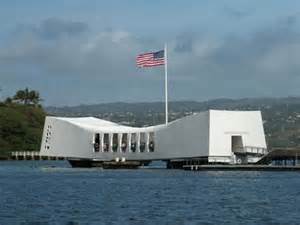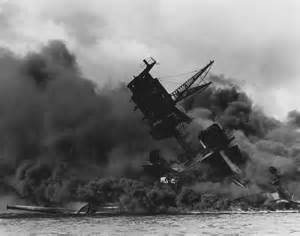Remembering Pearl Harbor: “A Date Which Will Live In Infamy”
From the desk of Jan Hommel, American Freedom Museum Director:
At 7:55 a.m. on December 7, 1941, a Japanese dive bomber appeared out of the clouds above the U.S naval base at Oahu Island’s Pearl Harbor. A swarm of 360 warplanes, launched from six aircraft carriers, followed and began a fierce attack on the base and the American ships that were anchored there. Most of the ships were only lightly manned because it was a Sunday morning. Two radar operators had spotted the large groups of aircraft in flight towards the island that morning, but with a flight of B-17’s expected from the United States at that time, they were told not to sound the alarm. This massive Japanese air assault came as a devastating surprise to the naval base and drew the United States irrevocably into World War II. Five battleships (the Arizona, Virginia, California, Nevada, and West Virginia), three destroyers, and seven other ships were sunk or capsized and more than 200 aircraft were destroyed, leaving but 43 operational. A total of 2,400 Americans were killed (1,000 on the Arizona alone) and 1,200 were wounded, many courageously attempting to fight off the Japanese. The Japanese lost around 30 planes, five midget submarines and fewer than 100 men.
Why Did the Japanese Bomb Pearl Harbor?
The Japanese bombed Pearl Harbor for several reasons. The tensions between Japan and the United States had been rising. When Japan occupied French Indochina in July 1941, President Roosevelt tried to avoid direct confrontation with the country. The Roosevelt administration eventually placed an oil embargo on Japan and demanded them to withdraw from China and the French Indochina, and to renounce their alliance with fascist Germany and Italy. They refused, demanding that the U.S. first end the embargo on oil shipments that were vital to their war machine. Japan’s ambitions in the Pacific placed her on a collision course with the United States, which controlled the Philippines and also had extensive economic interests throughout the region. When the United States imposed the oil embargo on Japan, threatening to suffocate her economy, Japan’s response was to risk everything on a massive strike which would knock the U. S. out of the Pacific, clearing the way for a Japanese conquest of resource-rich South East Asia. As a result, the Japanese army decided to attack the United States base at Pearl Harbor in a surprise air attack.


